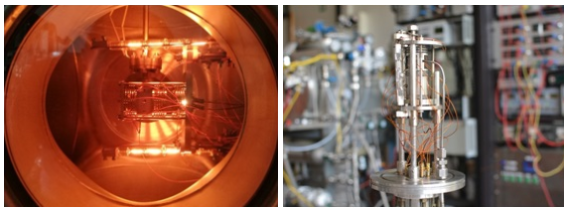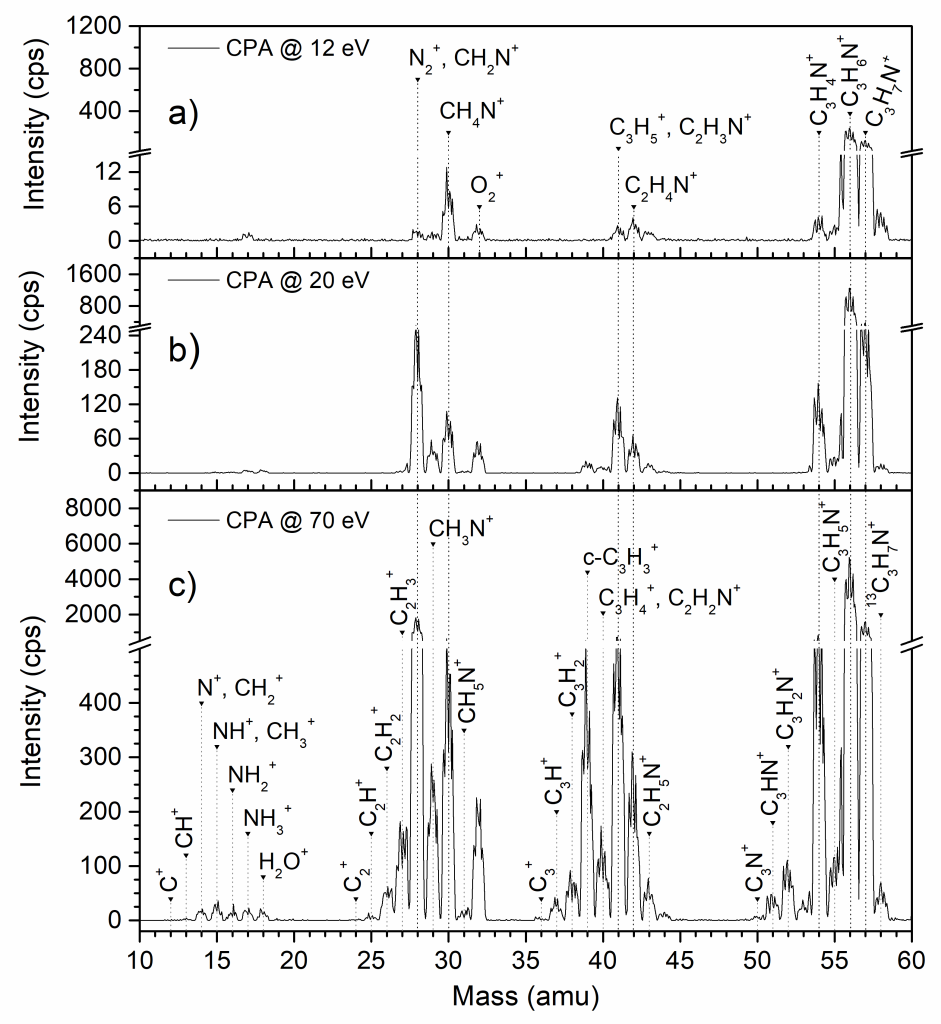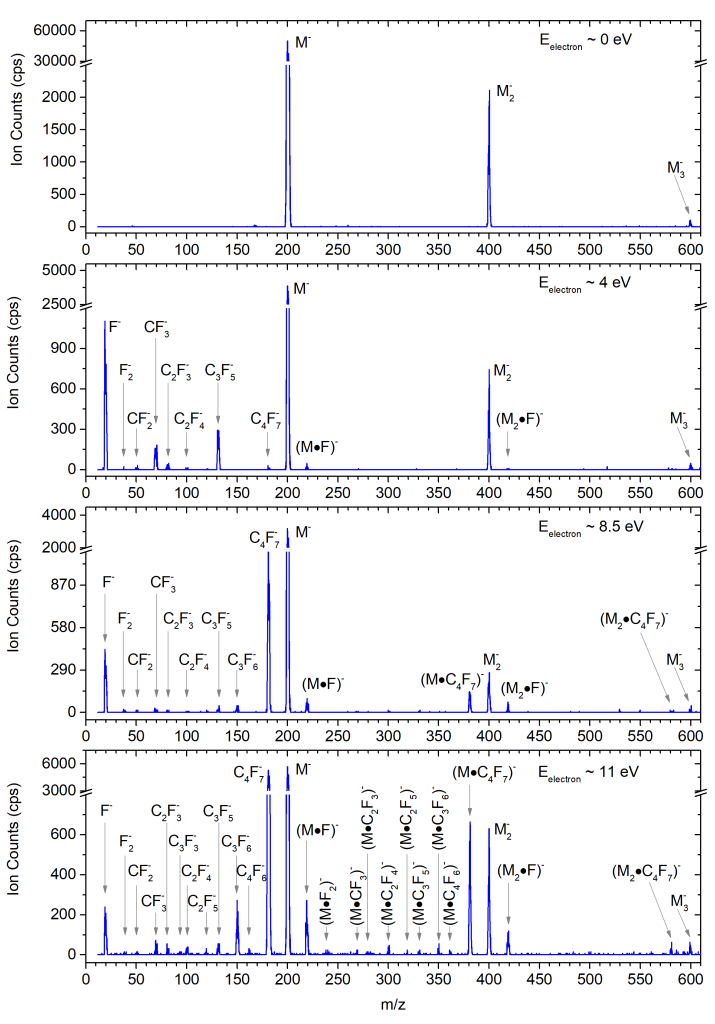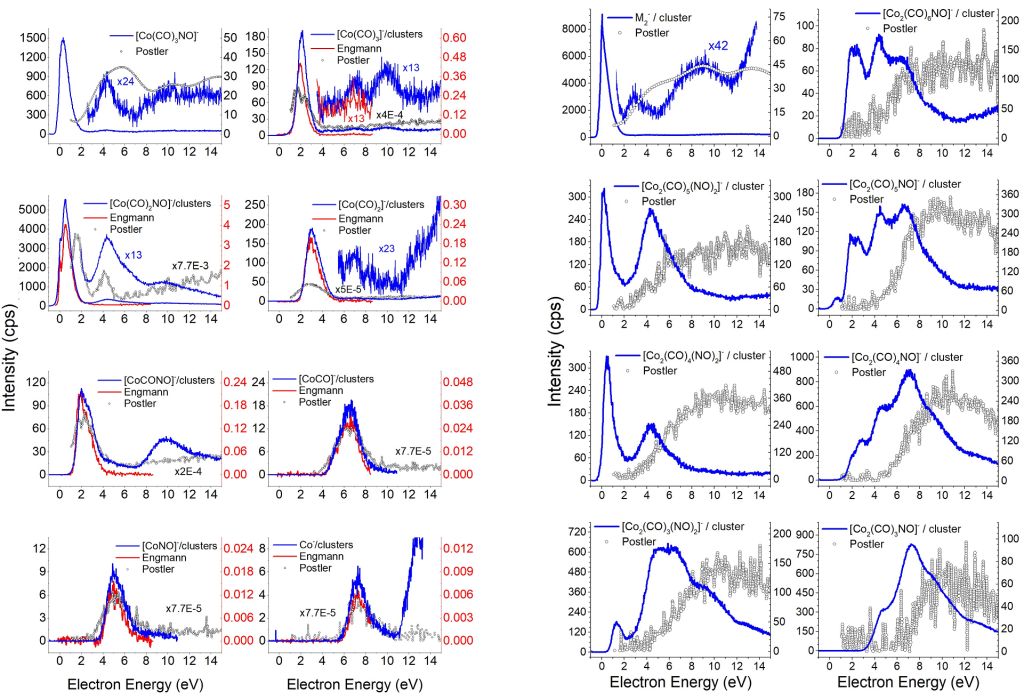To understand the mechanisms in plasma, it is essential to study the processes that are active within it. Due to the variety of processes occurring in discharges, it is challenging to investigate individual mechanisms directly in plasma. Electron-induced processes are among those present in discharges and play a significant role in plasma chemistry and decontamination, but they have increasing importance in astrochemistry, biomedicine, nanotechnologies based on non-plasma processing, an many other fields.
The main objectives of our group deal with electron–molecule ionization studies, investigated using the crossed-beam method combined with mass spectrometry to analyze the charged products of electron-induced reactions, with CEMBIA – a crossed-beam electron–molecule instrument (Fig. 1 left) and with CLUSTER-ILN – an electron–cluster beam system (Fig. 1 right). These experimental techniques can provide valuable insights into the kinetics of various processes — including evaluations of relative cross sections, efficiency of individual reaction channels, and the threshold energies, due to the well defined electron energies produced with Trochoidal Electron Monochromator (TEM, Fig. 2). Moreover, when combined with findings from the various research areas of our workgroup (electron induced fluorescence, ion mobility spectrometry), technology optimization can be achieved to the development of suitable plasma sources and devices with practical application potential. All these research areas investigated with our workgroup are supported with quantum-chemical calculations of molecular structures, various reaction pathways leading to ionic products, excited species, or clustering, an many more.

Fig. 1: Left is the schema of CEMBIA – Crossed Electron Molecular Beams Ionization Apparatus [https://doi.org/10.1063/1.24002361], (TEM – Trochoidal Electron Monochromator, MBS – Molecular Beam Source, QMS – Quadrupole Mass Spectrometer), right is the CLUSTER-ILN – Crossed Electron Molecular Cluster Beams Ionization Apparatus [https://doi.org/10.1021/cr00015a0062], (coexpansion of molecules in Ar gas).

Fig. 2: Trochoidal Electron Monochromator in the CEMBIA chamber (left) and of the CLUSTER-ILN setup (right).
Electron induced reactions play important role in many media and environments:
-
- dielectric discharges
- plasma in nature, plasma sources, plasma technologies
- atmosphere
- interstellar chemistry
- radiation chemistry
- nanofabrication, plasma based, focused electron beam technologies
Using the Crossed Electron/Molecule Beams Ionization Apparatus and the Electron/CLUSTER Beams Apparatus we measure:
-
- the mass spectra of the molecules/clusters (Fig. 3/4) using the BALZERS quadrupole mass analyzer, coupled with a trochoidal electron monochromator
- the relative cross sections of the ionization reactions:
- Electron impact ionization and dissociative ionization of molecules (Fig. 5 left):
-
-
-
- e + AB → AB+ + 2e
- e + AB → A+ + B + 2e
-
-
-
-
- Electron impact ionization and dissociative ionization of clusters (Fig. 5 right):
-
-
-
-
- e + (AB)m → ABm-1•AB+ + 2e
- e + (AB)m → ABm-1•A+ + B + 2e
- e + (AB)m → ABm-1•A + B+ + 2e
-
-
-
-
- Dissociative electron attachment to molecules (Fig. 6 left):
-
-
-
-
- e + AB ↔ AB*- → A– + B
-
-
-
-
- Dissociative electron attachment to clusters (Fig. 6 right):
-
-
-
-
- e + (AB)m ↔ ABm-1•AB*- → ABm-1•A– + B
- e + (AB)m ↔ ABm-1•AB*- → ABm-1•A + B–
-
-
-
- ionization energies of molecules/clusters, threshold energies of formation of ionic fragments
- gas temperature dependencies of the reactions

Fig. 3: The CEMBIA mass spectrum of CPA molecule recorded at 100 eV incident electron energy [https://doi.org/10.1016/j.ijms.2020.116390].

Fig. 4: The DEA CLUSTER-ILN mass spectrum of c-C4F8 clusters measured at different incident electron energies [https://doi.org/10.1140/epjd/s10053-023-00631-7].
 Fig. 5: Cross-sections of the dissociative ionization of CPA molecule with CEMBIA (left [https://doi.org/10.1016/j.ijms.2020.116390]) vs the dissociative ionization of Fe(CO)5 cluster with CLUSTER-ILN (right).
Fig. 5: Cross-sections of the dissociative ionization of CPA molecule with CEMBIA (left [https://doi.org/10.1016/j.ijms.2020.116390]) vs the dissociative ionization of Fe(CO)5 cluster with CLUSTER-ILN (right).

Fig. 6: Ion yields of DEA to Co(CO)3NO measured in gas phase with CEMBIA (red lines on left) vs DEA to Co(CO)3NO clusters with CLUSTER-ILN on right [https://doi.org/10.1039/D3CP05601E].
Collaborations:
- Nail Asfandiarov, Dr., Russian Academy of Sciences, Ufa, Russia
- Wieslawa Barszczewska, Prof. Dr., Univ. Siedlce, Poland
- Stephan Denifl, Dr., Univ. Innsbruck, Austria
- Sam Eden, Dr., Open University, United Kingdom
- Sarah Engmann,Univ. Reykjavik, Iceland
- Juraj Fedor, Dr., Czech Academy of Sciences, Czech Rep.
- Sascha Gohlke, Dr., Freie Univ. Berlin, Germany
- Eugen Illenberger, Prof., Freie Univ. Berlin, Germany
- Oddur Ingolfsson, Dr., Univ. Reykjavik, Iceland
- Antoni Jowko, Prof., AP Siedlce, Poland
- Jaroslav Kočišek, Dr., Czech Academy of Sciences, Czech Rep.
- Frantisek Krcma, Dr., Techn. Univ. Brno, Czech Rep.
- Judith Langer, Dr., Freie Univ. Berlin, Germany
- Nigel Mason, Porf., Univ. Kent, United Kingdom
- Isabel Martin, Freie Univ. Berlin, Germany
- Andreas Mauracher, Dr., Univ. Innsbruck, Austria
- Věra Mazánková, Prof., Techn. Univ. Brno, Czech Rep.
- Tilmann D. Märk, Prof., Univ. Innsbruck, Austria
- Bartosz Michalczuk, Univ. Siedlce, Poland
- Alexandar Milosavljević, Institute of Physics, Belgrade,Serbia
- Jelena Maljković, Institute of Physics, Belgrade,Serbia
- Benedikt Ómarsson,Univ. Reykjavik, Iceland
- Ivan Pshenichnyuk, Russian Academy of Sciences, Ufa, Russia
- Stanislav Pshenichnyuk, Dr., Russian Academy of Sciences, Ufa, Russia
- Sylwia Ptasinska, Dr., Univ. Innsbruck, Austria
- Pavel Schukin, Dr., Russian Academy of Sciences, Russia, Ufa
- Iwona Szamrej, Prof., Univ. Siedlce, Poland
- Petra Swiderek, Prof., Univ. Bremen, Germany
- David Trunec, Prof., Masaryk Univ. Brno, Czech Rep.
- Jonas Warneke, Univ. Bremen, Germany
- Jolana Wnorowski, Univ. Siedlce, Poland
- Karol Wnorowski, Univ. Siedlce, Poland
- Lenka Zajickova, Dr., Masaryk Univ. Brno, Czech Rep.
- Fabio Zappa, Dr., Univ. Innsbruck, Austria
- Mateusz Zawadski, Dr., Univ. of Technol. Gdansk, Poland
Postdoctorals:
- Experimental Physics – Mass Spectrometry of molecules and clusters:
- Beáta Feilhauerová (2018-2020), SCOPUS ID: 55179467500, WoS ResearcherID: EZA-5154-2022
- Marián Danko (2015-2019) – SCOPUS ID: 56698439700, WoS ResearcherID: ESO-3433-2022
- Michal Stano
Doctoral students:
- Experimental Physics – Mass Spectrometry of molecules and clusters:
- Dušan Mészáros (2019-2025) – Štúdium ionizačných procesov molekúl a klastrov indukovaných nízkoenegretickými elektrónmi
- Michal Lacko (2013-2018) – Using of a Mass Spectrometry for Study of an Electron-Molecular Interaction
- Jaroslav Kočišek (2006-2010) – Elektrónmi indukované reakcie biologicky významných molekúl
- Michal Stano
- Imre Ipoly
- Theoretical Modelling – Reactivity of molecules and clusters:
- Navya Arepalli (2024-) – Modeling of electron-induced processes in molecules and clusters with standard methods of quantum chemistry
Master students:
- Experimental Physics – Mass Spectrometry of molecules and clusters:
- Dušan Mészáros (2017-2019) – Porovnanie elektrón-molekulových a elektrón-klastrových procesov
- Michal Lacko (2012-2013) – Štúdium disociatívneho záchytu elektrónov na metaloorganické zlúčeniny
- Jaroslav Kočišek (2003-2006) –
- Michal Stano
- Imre Ipoly
- Theoretical Modelling – Reactivity of molecules and clusters:
- Samuel Peter Kovár (2024-2025) – Teoretické štúdium vlastností ionizovaných anizolov a ich fragmentov
- Alexandra Jančišinová (2025-) –
Bachelor students:
- Experimental Physics – Mass Spectrometry of molecules and clusters:
- Dušan Mészáros (2016-2017) – Experimentálne štúdium ionizačných procesov v molekulových klastroch pomocou nízkoenergetických elektrónov
- Ján Blaško (2016-2017) – Experimentálne štúdium disociatívnych procesov nárazom a záchytom elektrónu na molekulách
- Patrícia Multáňová (2016-2017) – Disociatívny elektrónový záchyt a elektrónová ionizácia biomolekúl
- Katarína Pisklová (2010-2011) – Interakcie elektrónov s biologicky významnými molekulami
- Theoretical Modelling – Reactivity of molecules and clusters:
- Alexandra Jančišinová (2024-2025) – Teoretické štúdium ionizačných a ión molekulových procesov pesticídu chlorpyrifos
- Samuel Peter Kovár (2023-2024) – Elektrónové a iónové procesy molekúl v plazme počítané pomocou kvantovo-chemických metód
- Daniel Pokorný (2020-2022) – Identifikácia konformérov rôznych neutrálnych a protonizovaných ftalátov pomocou teoretických výpočtov
Contact:
Doc. RNDr. Peter Papp, PhD., papp@fmph.uniba.sk, 00421 2 602 95 398, ORCID: 0000-0002-6943-2667, WoS ResearcherID: AAP-1239-2021
Prof. Štefan Matejčík, DrSc., matejcik@fmph.uniba.sk, 00421 2 602 95 686, ORCID: 0000-0001-7238-5964, WoS ResearcherID: J-9841-2013
Running projects:
- Plasma based methods for detection and degradation of pesticides, APVV-23-0522
- Comets‘ Organic Studies: Exploring the Mechanisms of Electron-Induced Chemistry – Joint Experimental and Theoretical Approach, APVV SK-PL-23-0050
- Reactions of electrons and ions with environmental pollutants studied by novel spectrometric methods, VEGA 1/0553/22
Selected list of our MS publications:
- Mészáros D, Matejčík Š and Papp P, Formation of negative ions from cobalt tricarbonyl nitrosyl Co(CO) 3 NO clusters. Phys. Chem. Chem. Phys. 2024, 26, 7522–33, https://doi.org/10.1039/D3CP05601E
- Mészáros D, Papp P and Matejčík Š, Dissociative electron attachment to c-C4F8 molecules and clusters. Eur. Phys. J. D 77 2023, 77, 62, https://doi.org/10.1140/epjd/s10053-023-00631-7
- Papp P, Danko M and Matejčík Š, Electron ionization and photoionization of cyclopropylamine Int. J. Mass Spectrom. 2020, 455, 116390, https://doi.org/10.1016/j.ijms.2020.116390
- Lacko M, Papp P, Szymańska I B, Szłyk E and Matejčík Š, Electron interaction with copper(II) carboxylate compounds. Beilstein J. Nanotechnol. 2018, 9, 384–98, https://doi.org/10.3762/bjnano.9.38
- Lacko M, Papp P and Matejčík Š, Dissociation of dicyclohexyl phthalate molecule induced by low-energy electron impact. J. Chem. Phys. 2018, 148, https://doi.org/10.1063/1.5026406
- Allan M, Lacko M, Papp P, Matejčík Š, Zlatar M, Fabrikant I I, Kočišek J and Fedor J, Dissociative electron attachment and electronic excitation in Fe(CO)5. Phys. Chem. Chem. Phys. 2018, 20, 11692–701, https://doi.org/10.1039/c8cp01387j
- Asfandiarov N L, Muftakhov M V., Pshenichnyuk S A, Papp P, Danko M, Lacko M, Blaško J, Matejčik S and Modelli A, Dissociative electron attachment to 2,4,6-trichloroanisole and 2,4,6-tribromoanisole molecules. J. Chem. Phys. 2017, 147, 234302, https://doi.org/10.1063/1.5007816
- Lengyel J, Papp P, Matejčík Š, Kočišek J, Fárník M and Fedor J, Suppression of low-energy dissociative electron attachment in Fe(CO)5 upon clustering. Beilstein J. Nanotechnol. 2017, 8, 2200–7, https://doi.org/10.3762/bjnano.8.219
- Warneke J, Van Dorp W F, Rudolf P, Stano M, Papp P, Matejčík Š, Borrmann T and Swiderek P, Acetone and the precursor ligand acetylacetone: Distinctly different electron beam induced decomposition? Phys. Chem. Chem. Phys. 2015, 17, 1204–16, https://doi.org/10.1039/c4cp04239e
- Lacko M, Papp P, Wnorowski K and Matejčík Š, Electron-induced ionization and dissociative ionization of iron pentacarbonyl molecules. Eur. Phys. J. D 2015, 69, 84, https://doi.org/10.1140/epjd/e2015-50721-8
- Alsheikh A A, Žídek J, Krčma F, Papp P, Lacko M and Matejčík Š, Fragmentation of methylphenylsilane and trimethylphenylsilane: A combined theoretical and experimental study. Int. J. Mass Spectrom. 2015, 385, 1–12, https://doi.org/10.1016/j.ijms.2015.05.004
- Papp P, Lacko M, Mészáros D, Stano M, Mach P and Matejčík Š, An experimental and theoretical study of electron impact ionization and dissociative electron attachment to trimethyl borate. Int. J. Mass Spectrom. 2014, 365–366, 157–62, https://doi.org/10.1016/j.ijms.2014.01.015
- Wnorowska J, Kočišek J, Matejčík Š, Dissociative electron attachment study to halocarbon-derivatives of nitro-benzene. Int. J. Mass Spectrom. 2014, 365-366, 177–180, https://doi.org/10.1016/j.ijms.2014.01.025
- Papp P, Engmann S, Kučera M, Stano M, Matejčík Š and Ingólfsson O, An experimental and theoretical study on structural parameters and energetics in ionization and dissociation of cobalt tricarbonyl nitrosyl. Int. J. Mass Spectrom. 2013, 356, 24–32, https://doi.org/10.1016/j.ijms.2013.09.011
- Engmann S, Stano M, Papp P, Brunger M J, Matejčík Š and Ingólfsson O, Absolute cross sections for dissociative electron attachment and dissociative ionization of cobalt tricarbonyl nitrosyl in the energy range from 0 eV to 140 eV. J. Chem. Phys. 2013, 138, 044305, https://doi.org/10.1016/j.ijms.2013.09.011
- Papp P, Shchukin P, Kočíšek J and Matejčík Š, Electron ionization and dissociation of aliphatic amino acids. J. Chem. Phys. 2012, 137, 105101, https://doi.org/10.1063/1.4749244
- Engmann S, Stano M, Matejčík Š, Ingólfsson O, Gas phase low energy electron induced decomposition of the focused electron beam induced deposition (FEBID) precursor trimethyl (methylcyclopentadienyl) platinum(iv) (MeCpPtMe3). Phys. Chem. Chem. Phys. 2012, 14, 14611–14618, https://doi.org/10.1039/c2cp42637d
- Kočišek J, Stružínský O, Sahánková H, Krčma F, Matejčík Š, Electron ionization of dimethylphenylsilane – Appearance energies of selected ionic fragments. Plasma Process. Polym. 2012, 9, 298–303, https://doi.org/10.1002/ppap.201100079
- Wnorowski K, Stano M, Matias C, Denifl S, Barszczewska W, Matejčík Š, Low-energy electron interactions with tungsten hexacarbonyl – W(CO)6. Rapid Commun. Mass Spectrom. 2012, 26, 2093–2098, https://doi.org/10.1002/rcm.6324
- Wnorowski K, Stano M, Barszczewska W, Jówko A, Matejčík S, Electron ionization of W(CO) 6: Appearance energies. Int. J. Mass Spectrom. 2012, 314, 42–48, https://doi.org/10.1016/j.ijms.2012.02.002
- Engmann S, Stano M, Matejčík S, Ingólfsson O, The role of dissociative electron attachment in focused electron beam induced processing: A case study on cobalt tricarbonyl nitrosyl. Angewandte Chemie – International Edition 2011, 50, 9475–9477, https://doi.org/10.1002/anie.201103234
- Milosavljević A R, Kočišek J, Papp P, Kubala D, Marinković B P, Mach P, Urban J and Matejčík Š. Electron impact ionization of furanose alcohols. J. Chem. Phys. 2010, 132, 1–11, https://doi.org/10.1063/1.3352422
- Kočišek J, Papp P, Mach P, Vasil’ev Y V., Deinzer M L and Matejčík Š, Resonance electron capture by Serine. J. Phys. Chem. A 2010, 114, 1677–83, https://doi.org/10.1021/jp906636b
- Papp P, Shchukin P and Matejčík Š, Specific formation of negative ions from leucine and isoleucine molecules. J. Chem. Phys. 2010, 132, 014301, https://doi.org/10.1063/1.3270154
- Kubala D, Drage E A, Al-Faydhi A M E, Kočíšek J, Papp P, Matejčík V, Mach P, Urban J, Limão-Vieira P, Hoffmann S V., Matejčík Š and Mason N J, Electron impact ionisation and UV absorption study of α- and β-pinene. Int. J. Mass Spectrom. 2009, 280, 169–73, https://doi.org/10.1016/j.ijms.2008.07.035
- Papp P, Urban J, Matejčík Š, Stano M and Ingolfsson O, Dissociative electron attachment to gas phase valine: A combined experimental and theoretical study. J. Chem. Phys. 2006, 125, 204301, https://doi.org/10.1063/1.2400236
- Denifl S, Matejčík S, Skalný J D, Märk T D, Electron impact ionization of CH3D and CD4 near threshold: Isotope and temperature effects. Int. J. Mass Spectrom. 2006, 248, 29–35, https://doi.org/10.1016/j.ijms.2005.10.007
- Langer J, Stano M, Gohlke S, Foltin V, Matejcik S, Illenberger E, Reactions in trifluoroacetic acid (CF3COOH) induced by low energy electron attachment. Chem. Phys. Lett. 2006, 419, 228–232, https://doi.org/10.1016/j.cplett.2005.11.073
- Sedlacko T, Balog R, Lafosse A, Stano M, Matejcik S, Azria R, Illenberger E, Reactions in condensed formic acid (HCOOH) induced by low energy (< 20 eV) electrons. Phys. Chem. Chem. Phys. 2005, 7, 1277–1282, https://doi.org/10.1039/b419104h
- Ipolyi I, Matejcik S, Illenberger E, Temperature dependence of electron attachment to CHCl2Br: A crossed beams study. EPJ D 2005, 35, 257–260, https://doi.org/10.1140/epjd/e2005-00228-0
- Denifl S, Matejčík S, Skalný JD, Stano M, Mach P, Urban J, Scheier P, Märk TD, Barszczewska W, Electron impact ionization of C3H8: Appearance energies and temperature effects. Chem. Phys. Lett. 2005, 402, 80–87, https://doi.org/10.1016/j.cplett.2004.12.009
- Ipolyi I, Matejcik S, Lukac P, Skalny JD, Mach P, Urban J, Temperature dependence of electron attachment to CHCLBr2: Crossed beams study. Int. J. Mass Spectrom. 2004, 233, 193–197, https://doi.org/10.1016/j.ijms.2003.12.017
- Vašeková E, Stano M, Matejčík Š, Skalný J D, Mach P, Urban J, Märk T D, Electron impact ionization of C2H6: Ionization energies and temperature effects. Int. J. Mass Spectrom. 2004, 235, 155–162, https://doi.org/10.1016/j.ijms.2004.04.011
- Matejčík Š, Foltin V, Stano M, Skalný J D, Temperature dependencies in dissociative electron attachment to CCl4, CCl2F2, CHCl3 and CHBr3. Int. J. Mass Spectrom. 2003, 223-224, 9–19, https://doi.org/10.1016/S1387-3806(02)00776-5
- Stano M, Foltin V, Matejcik S, Langer J, Gohlke S, Ellenberger E, A study of dissociative electron attachment to CHBr3 and CHI3. J. Phys. B: At. Mol. Opt. Phys. 2003, 36, 443–452, https://doi.org/10.1088/0953-4075/36/3/304
- Stano M, Matejcik S, Skalny J D, Märk T D, Electron impact ionization of CH4: Ionization energies and temperature effects. J. Phys. B: At. Mol. Opt. Phys. 2003, 36, 261–271, https://doi.org/10.1088/0953-4075/36/2/307
Selected list of co-author MS publications:
- Papp P, Mazánková V, Moravský L, Blaško J, Sťahel P, Prokeš L, Horňák R, Lehocký M, Pištěková H, Trunec D, Comparison of Plasma Polymerized Thin Films Deposited from 2-Methyl-2-oxazoline and 2-Ethyl-2-oxazoline: II Analysis of Deposition Process. Int. J. Mol. Sci. 2025, 26, 1–18, https://doi.org/10.3390/ijms26178641
- Pshenichnyuk S A, Asfandiarov N L, Vorob’ev A S , Matejčík Š, State of the art in dissociative electron attachment spectroscopy and its prospects. Physics-Uspekhi 2022, 65,163–188, https://doi.org/10.3367/UFNe.2021.09.039054
- Große-Kreul S, Hübner S, Schneider S, Ellerweg D, Von Keudell A, Matejčík S, Benedikt J, Mass spectrometry of atmospheric pressure plasmas. PSST 2015, 24, 044008, https://doi.org/10.1088/0963-0252/24/4/044008
- Sulzer P, Mauracher A, Denifl S, Zappa F, Ptasinska S, Beikircher M, Bacher A, Wendt N, Aleem A, Rondino F, Matejcik S, Probst M, Mäk T D, Scheier P, Identification of isomers of nitrotoluene via free electron attachment. Anal. Chem. 2007, 79, 6585–6591, https://doi.org/10.1021/ac070656b
- Huber D, Beikircher M, Denifl S, Zappa F, Matejcik S, Bacher A, Grill V, Märk T D, Scheier P, High resolution dissociative electron attachment to gas phase adenine. J. Chem. Phys. 2006, 125, 084304, https://doi.org/10.1063/1.2336775
- Ptasińska S, Denifl S, Candori P, Matejcik S, Scheier P, Märk T D, Dissociative electron attachment to gas phase alanine. Chem. Phys. Lett. 2005, 403, 107–112, https://doi.org/10.1016/j.cplett.2004.12.115
- Denifl S, Matejcik S, Ptasinska S, Gstir B, Probst M, Scheier P, Illenberger E, Mark T D, Electron attachment to chlorouracil: A comparison between 6-ClU and 5-ClU. J. Chem. Phys. 2004, 120, 704–709, https://doi.org/10.1063/1.1630959
- Denifl S, Ptasinska S, Hanel G, Gstir B, Scheier P, Probst M, Farizon B, Farizon M, Matejcik S, Illenberger E, Märk T D, Electron attachment to uracil, thymine and cytosine. Phys. Scr. T 2004, T110, 252–255, https://doi.org/10.1238/Physica.Topical.110a00252
- Cicman P, Gluch K, Pelc A, Sailer W, Matt-Leubner S, Scheier P, Matejcik S, Lukac P, Robertson W D, Compton R N, Mark T D, Electron impact ionization of CHF2Cl: Unusual ordering of ionization energies for parent and fragment ions. J. Chem. Phys. 2003, 119, 11704–11711, https://doi.org/10.1063/1.1622665
- Denifl S, Matejcik S, Gstir B, Hanel G, Probst M, Scheier P, Märk T D, Electron attachment to 5-chloro uracil. J. Chem. Phys. 2003, 118, 4107–4114, https://doi.org/10.1063/1.1540108
- Langer J, Stano M, Gohlke S, Rosa A, Barszczewska W, Matejcik S, Illenberger E, Low energy (0-15 eV) electron stimulated reactions in single 1,2-C2F4Cl2 molecules and clusters. Int. J. Mass Spectrom. 2003, 223–224, 193–204, https://doi.org/10.1016/S1387-3806(02)00790-X
- Gstir B, Denifl S, Hanel G, Rümmele M, Fiegele T, Stano M, Feketeova L, Matejcik S, Becker K, Scheier P, Märk T D, High resolution multiple electron impact ionisation of He, Ne, Ar, Kr and Xe atoms close to threshold: Appearance energies and Wannier exponents. Nucl. Instrum. Methods Phys. Res. B 2003, 205, 413–416, https://doi.org/10.1016/S0168-583X(02)02042-6
- Pelc A, Sailer W, Matejcik S, Scheier P, Märk T D, Dissociative electron attachment to nitroethane: C2H 5NO2. J. Chem. Phys. 2003, 119, 7887–7892, https://doi.org/10.1063/1.1607314
- Denifl S, Gstir B, Hanel G, Feketeova L, Matejcik S, Becker K, Stamatovic A, Scheier P, Märk T D, Multiple ionization of helium and krypton by electron impact close to threshold: Appearance energies and Wannier exponents. J. Phys. B: At. Mol. Opt. Phys. 2002, 35, 4685–4694, https://doi.org/10.1088/0953-4075/35/22/310
- Langer J, Matejcik S, Illenberger E, Energy balance in dissociative electron attachment to C2F5I. Phys. Chem. Chem. Phys. 2002, 4, 5105–5109, https://doi.org/10.1039/b205989d
- Sailer W, Pelc A, Matejcik S, Illenberger E, Scheier P, Märk T D, Dissociative electron attachment study to nitromethane. J. Chem. Phys. 2002, 117, 7989–7994, https://doi.org/10.1063/1.1510446
- Gstir B, Denifl S, Hanel G, Rümmele M, Fiegele T, Cicman P, Stano M, Matejcik S, Scheier P, Becker K, Stamatovic A, Märk T D, Electron impact multiple ionization of neon, argon and xenon atoms close to threshold: Appearance energies and Wannier exponents. J. Phys. B: At. Mol. Opt. Phys. 2002, 35, 312, 2993–3007, https://doi.org/10.1088/0953-4075/35/13/312
- Langer J, Matejcik S, Illenberger E, Electron attachment to C2F5I molecules and clusters. Int. J. Mass Spectrom. 2002, 220, 21–220, https://doi.org/10.1016/S1387-3806(02)00668-1
- Schramm A, Ruf M-W, Stano M, Matejcik S, Fabrikant I I, Hotop H, High-resolution study of dissociative electron attachment to dipolar molecules at low energies: CH2Br2 and CCl3Br. J. Phys. B: At. Mol. Opt. Phys. 2002, 35, 4179–4202, https://doi.org/10.1088/0953-4075/35/20/306
- Skalny J D, Matejcik S, Mikoviny T, Vencko J, Senn G, Stamatovic A, Märk T D, Absolute calibration of relative electron attachment cross sections measured by crossed-beams experiments. Int. J. Mass Spectrom. 2001, 205, 77–84, https://doi.org/10.1016/S1387-3806(00)00272-4
- Spanel P, Smith D, Matejcik S, Kiendler A, Märk T D, A coordinated flowing afterglow and crossed beam study of electron attachment to CCl3Br. Int. J. Mass Spectrom. Ion Proc. 1997, 167–168, 1–12, https://doi.org/10.1016/s0168-1176(97)00028-1
- Matejcik S, Kiendler A, Cicman P, Skalny J, Stampfli P, Illenberger E, Chu Y, Stamatovic A, Märk T D, Electron attachment to molecules and clusters of atmospheric relevance: Oxygen and ozone, PSST 1997, 6, 140–146, https://doi.org/10.1088/0963-0252/6/2/007
- Lehmann L, Matejcik S, Illenberger E, Observation of the Nucleophilic Displacement (SN2) Reaction F-+CH3Br→CH3F + Br- Induced by Dissociative Electron Capture in Binary van der Waals Clusters. Berichte der Bunsengesellschaft/Phys. Chem. Chem. Phys. 1997, 101, 287–290, https://doi.org/10.1002/bbpc.19971010218
- Ruckhaberle N, Lehmann L, Matejcik S, Illenberger E, Bouteiller Y, Periquet V, Museur L, Desfrançois C, Schermann J-P, Free electron attachment and Rydberg electron transfer to NF3 molecules and clusters. J. Phys. Chem. A 1997, 101, 9942–9947, https://doi.org/10.1021/jp972422+
- Kiendler A, Matejcik S, Skalny J D, Stamatovic A, Märk T D, Dissociative electron attachment to CF2Cl2 using a high-resolution crossed-beams technique. J. Phys. B: At. Mol. Opt. Phys. 1996, 29, 6217–6225, https://doi.org/10.1088/0953-4075/29/24/026
- Matejcik S, Eichberger P, Plunger B, Kiendler A, Stamatovic A, Märk T D, Dissociative electron attachment to SF6: production of SF5- at temperatures below 300 K. Int. J. Mass Spectrom. Ion Proc. 1995, 144, L13–L17, https://doi.org/10.1016/0168-1176(95)04167-J
- Spanel P, Matejcik S, Smith D, The varying influences of gas and electron temperatures on the rates of electron attachment to some selected molecules. J. Phys. B: At. Mol. Opt. Phys. 1995, 28, 2941–2957, https://doi.org/10.1088/0953-4075/28/14/015
Selected list of our publications about theoretical modelling:
- Michalczuk B, Papp P, Mészáros D, Stachová B, Moravský L, Matejčík Š and Barszczewska W, Thermal electron attachment to halogenated silanes in the gas phase. Rapid Commun. Mass Spectrom. 2024, 38, 1–10, https://doi.org/10.1002/rcm.9897
- Moravský L, Borkhari A F, Adamov A Y, Sysoev A A, Papp P and Matejčík Š, Negative Atmospheric Pressure Chemical Ionization of Chlorinated Hydrocarbons. Studied by Ion Mobility Spectrometry (IMS) and IMS-MS Techniques. J. Am. Soc. Mass Spectrom. 2022, 33, 1569–76, https://doi.org/10.1021/jasms.2c00139
- Bockova J, Rebelo A, Ryszka M, Pandey R, Mészáros D, Limao-Vieira P, Papp P, Mason N J, Townsend D, Nixon K, Vizcaino V, Poully J-C and Eden S, Thermal desorption effects on fragment ion production from multi-photon ionized uridine and selected analogues. RSC Adv. 2021, 11, 20612–21, https://doi.org/10.1039/d1ra01873f
- Moravský L, Michalczuk B, Fateh Borkhari A, Papp P, Sysoev A A and Matejčík Š, Study of atmospheric pressure chemical ionization of phthalates in air by ion mobility spectrometry/mass spectrometry. Rapid Commun. Mass Spectrom. 2021, 35, https://doi.org/10.1002/rcm.9145
- Michalczuk B, Moravský L, Papp P, Mach P, Sabo M and Matejčík Š, Isomer and conformer selective atmospheric pressure chemical ionisation of dimethyl phthalate. Phys. Chem. Chem. Phys. 2019, 21, 13679–85, https://doi.org/10.1039/c9cp02069a
- Papp P, Matejčík Š, Mach P, Urban J, Paidarová I and Horáček J, Analytical continuation in coupling constant method; Application to the calculation of resonance energies and widths for organic molecules: Glycine, alanine and valine and dimer of formic acid. Chem. Phys. 2013, 418, 8–13, https://doi.org/10.1016/j.chemphys.2013.03.023
- Papp P, Neogrady P, Mach P, Pittner J, Hubač I and Wilson S, Many-body Brillouin-Wigner second-order perturbation theory: An application to the autoaromatisation of hex-3-ene-1,5-diyne (the Bergman reaction). Mol. Phys. 2008, 106, 57–74, https://doi.org/10.1080/00268970701832355
- Papp P, Mach P, Hubač I and Wilson S, Many-body Brillouin-Wigner second-order perturbation theory: A robust and efficient approach to the multireference correlation problem. Int. J. Quantum Chem. 2007, 107, 2622–31, https://doi.org/10.1002/qua.21514
- Papp P, Mach P, Pittner J, Huba I and Wilson S, Many-body Brillouin-Wigner second-order perturbation theory using a multireference formulation: An application to bond breaking in the diatomic hydrides BH and FH. Mol. Phys. 2006, 104, 2367–86, https://doi.org/10.1080/00268970600662499
- Hubač I, Mach P, Papp P and Wilson S, Multireference second-order Brillouin-Wigner perturbation theory. Mol. Phys. 2004, 102, 701–9, https://doi.org/10.1080/00268970410001698955